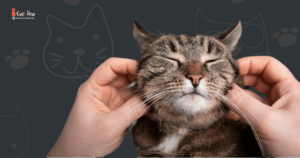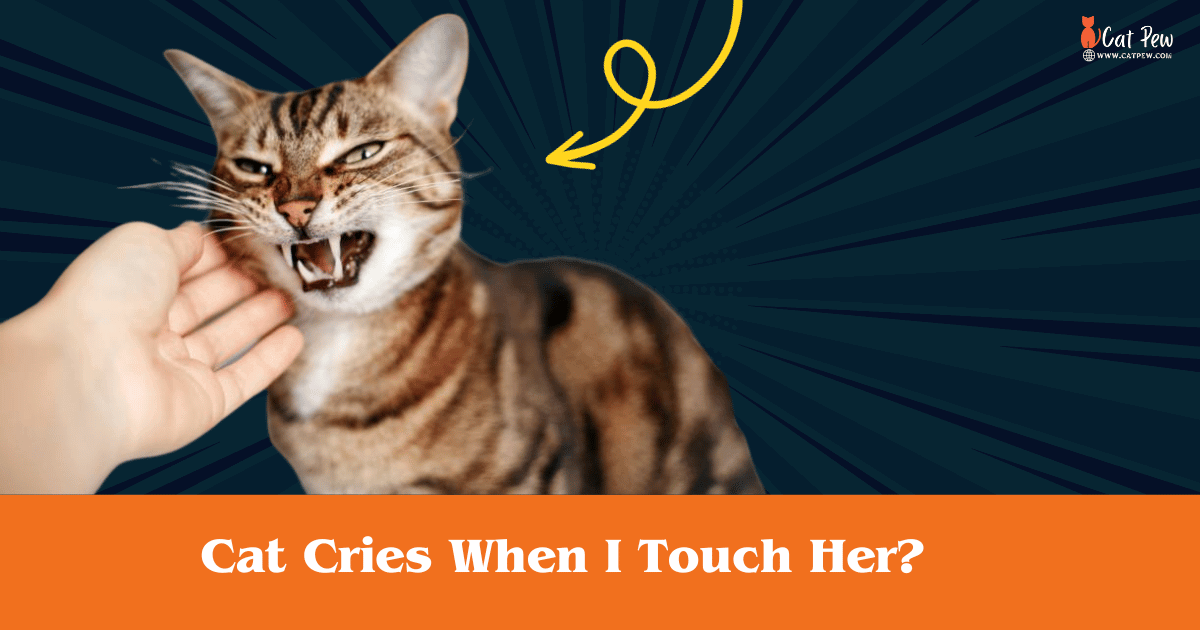Cat Cries When I Touch Her?
Cat cries when you touch her. This behavior may indicate pain or discomfort.
Is your cat crying when you touch her? It’s essential to address this issue to ensure your cat’s well-being. We will explore the potential reasons behind your cat’s crying and provide solutions to help alleviate their distress. Understanding why your cat is crying when you touch her is crucial to providing the appropriate care and support.
Observing their behavior, consulting with a veterinarian, and implementing the recommended strategies can help your cat feel more comfortable and minimize their crying. Let’s dive into the possible causes and solutions to address this issue.
Unraveling Cat’s Distress Signals

Cats are often viewed as mysterious creatures, capable of expressing themselves through subtle cues that are sometimes challenging for humans to decipher. One distress signal that cat owners may encounter is when their feline companion cries or meows when they touch them, particularly on the back. To better understand why cats exhibit this behavior, delving into feline communication and learning to recognize signs of discomfort or pain is essential.
Understanding Feline Communication
Cats have a sophisticated repertoire of communication skills, utilizing a combination of vocalizations, body language, and scent marking to convey their emotions and needs. While meowing is typically associated with communication between cats and humans, it is essential to note that cats primarily use this vocalization to elicit attention and engage with their owners. A crying meow when you touch your cat’s back could indicate a distress signal, as she is attempting to communicate her discomfort or pain to you. You can gain insights into her emotional state by paying close attention to your cat’s body language and vocal cues.
Recognizing Discomfort In Cats
Cats are masters at masking their pain and discomfort, often exhibiting subtle signs that may be easily overlooked. To better understand if your cat is in distress, observing her behavior and looking for any abnormal changes is vital. Symptoms that your cat may be experiencing discomfort or pain include:
- Increased vocalization, such as meowing or crying
- Changes in appetite or drinking behaviors
- Altered litter box habits, such as avoiding the litter box or straining during urination
- Excessive grooming or licking of a particular area
- Aggression or withdrawal from social interactions
By being attentive to these signs and monitoring your cat’s behavior, you can start to piece together clues to identify the source of her distress.
How Do You Know If A Cat Is In Pain
Knowing whether your cat is experiencing pain can be challenging, but some common indicators can help you assess her condition. Some signs that may indicate your cat is in pain include:
- Changes in appetite or a decrease in food intake
- Altered grooming habits, such as neglecting personal hygiene
- Reluctance to engage in physical activities or playing
- Unusual body postures, such as hunching or tensing
- Excessive licking or biting of a specific area
Suppose your cat cries when you touch her back. In that case, it is essential to consult with a veterinarian to rule out any underlying medical conditions or injuries that may be causing her distress. Veterinary professionals can provide comprehensive assessments and offer appropriate treatments to help alleviate your feline companion’s pain.
In conclusion, understanding feline communication and recognizing signs of discomfort or pain are crucial in unraveling your cat’s distress signals. By paying close attention to her body language, vocalizations, and behavioral changes, you can better understand her needs and provide the necessary care and support.
Cat Cries: Pain Or Protest?

Cats are known for their unique vocalizations; their cries can vary in tone, volume, and duration. As a cat owner, it can be concerning when your feline companion starts crying, especially when you touch her. But what do these cries mean? Are they a sign of pain or just a form of protest?
Differentiating Between Types Of Cries
Understanding the different types of cries can help determine whether your cat is experiencing pain or simply expressing dissatisfaction. Here are some familiar cat cries:
- Meowing: This is the most common vocalization cats use to communicate with humans. It can indicate various needs, such as hunger, attention, or wanting to go outside.
- Yowling: This long and intense cry usually indicates distress or pain. It is often associated with mating behaviors or territorial disputes.
- Hissing: When a cat hisses, it is a warning sign that she feels threatened or scared. This cry is accompanied by a defensive posture, arched back, and raised fur.
Typical Scenarios When Cats Vocalize
Cats are known for being independent and sometimes aloof but also highly communicative creatures. Here are some common scenarios when cats vocalize:
- Feeding time: Cats often meow to indicate that they are hungry or want food.
- Attention-seeking: Your cat may cry for attention, whether engaging in playtime or simply wanting you to acknowledge her presence.
- Loneliness: Cats are social animals, and when left alone for long periods, they may cry to express their loneliness.
How Do I Know If My Cat Has Back Pain?
If your cat cries when you touch her, particularly on her stomach, it’s essential to consider whether she might be experiencing back pain. Here are some signs that indicate your cat may have back pain:
- Changes in posture: Your cat may exhibit a hunched or arched back, preferring to lie in a different position than usual.
- Reluctance to jump or climb: Pain in the back can limit your cat’s mobility, making her hesitant to jump or climb onto higher surfaces.
- Decreased appetite: Back pain can affect your cat’s well-being, reducing need.
Always consult with a veterinarian if you suspect your cat is experiencing pain. They can provide a proper diagnosis and recommend the appropriate treatment.
The Touch-cry Connection

It can be concerning and confusing when your cat starts crying whenever you touch her. The touch-cry connection is a unique phenomenon that cat owners may encounter, and it stems from a combination of bonding rituals, cats’ personal space, and their boundaries. Understanding these factors can help unravel why your furry friend expresses her discomfort through tears.
Bonding Rituals And Cat’s Reactions
When it comes to bonding rituals, cats have their unique ways of expressing themselves. While some cats may enjoy being petted and touched all over their bodies, others may have specific preferences or sensitive areas. If your cat cries when you touch her back, it could be a sign that she has a particular sensitivity in that area.
It’s essential to pay attention to your cat’s body language and reactions during bonding rituals. Notice if your cat becomes tense or flinches when you touch her back. This could indicate that she is experiencing discomfort or pain in that specific area. Cats are masters at hiding their pain, so being observant and responsive to their signals is essential.
Additionally, your relationship with your cat plays a significant role in her reactions. Cats that feel loved, secure, and trust their owners are likelier to tolerate touch and show contentment. Conversely, if your cat cries when you touch his back, it could indicate a deeper emotional or physical issue that warrants further investigation.
Cats’ Personal Space And Boundaries
Like humans, cats have personal space and boundaries that should be respected. Cats are known for their independent nature and generally prefer interactions on their terms. When your cat cries when you touch her, it could be her way of setting boundaries and asserting her need for personal space.
It’s crucial to understand and respect your cat’s personal space to maintain a harmonious relationship. Respectful petting techniques and a gentle touch can help build trust and communication between you and your cat. Please watch her body language and cues to know when she has had enough or needs a break.
If your cat consistently cries when you touch her, it may be beneficial to consult a veterinarian to rule out any underlying medical conditions that could be causing discomfort. Your vet can perform a thorough examination and guide you on how to address best any physical or emotional issues your cat may be experiencing.
Remember, each cat is unique, and what works for one may not work for another. Patience, understanding, and open communication are essential when navigating the touch-cry connection. By respecting your cat’s boundaries and addressing potential concerns, you can help create a safe and loving environment for your feline companion.
Sensitivity Spots In Felines

Sensitivity spots in felines play an essential role in interacting with their environment. Understanding these sensitive areas on a cat’s body can help you form a stronger bond with your furry friend and provide them with the gentle touch they need. In this article, we will explore the common sensitive areas in cats and discuss how hypersensitivity issues can affect their well-being.
Common Sensitive Areas On A Cat’s Body
1. Ears: A cat’s ears are lined with susceptible nerves, making them one of the most sensitive areas on the body. Gently massaging the base of the ears can provide relaxation and comfort.
2. Whiskers: Whiskers are connected to nerve endings, allowing cats to perceive their surroundings. Avoid tugging or pulling on their whiskers, which can cause discomfort and distress.
3. Paws: Cats have numerous nerve endings in their paws, so they are often sensitive about touching their paws. Gradually introducing handling and providing positive experiences can help desensitize them to paw touching.
4. Belly: While some cats enjoy belly rubs, others are sensitive. Approaching with gentle strokes and respecting their boundaries will help build trust and prevent adverse reactions.
5. Tail: The tail is a vital communication tool for cats. Pulling or tugging on their tail can be painful and may lead to negative behaviors. Instead, offer soft strokes or play with toys at a safe distance from their tail.
Cats With Hypersensitivity Issues
Some cats may have hypersensitivity issues, causing them to react strongly to even the lightest touch. This heightened sensitivity can be attributed to various factors, including genetic predisposition, previous trauma, or medical conditions.
If you notice your cat displaying signs of hypersensitivity, such as vocalization or aggression when touched, it is essential to consult with a veterinarian. They can examine your cat, rule out any underlying medical conditions, and help determine the best course of action to address their hypersensitivity issues.
Remember, every cat is unique, and while one may enjoy being touched in certain areas, another may be extremely sensitive. Paying attention to your cat’s body language and respecting their boundaries is crucial in fostering a positive and loving relationship.
Behavioral Insights

Understanding the behavior of our feline friends can sometimes be a complex puzzle to solve. While cats may seem mysterious and independent, they communicate with us through various cues and actions, including vocalization.
The Impact Of Past Trauma On Behavior
Just like humans, cats can carry emotional baggage from their past experiences. Traumatic events such as abuse, neglect, or a sudden change in their environment can profoundly impact their behavior. If your cat cries or shows signs of distress when you touch her, it’s crucial to consider any past trauma she may have endured.
- Flinching or cowering when approached
- Avoiding physical contact or tense body language
- Excessive grooming or hiding
- Reactive behavior, such as hissing, scratching, or biting
If your cat exhibits any of these signs, it’s essential to approach her with patience and empathy. Remember that building trust takes time and effort, especially for a cat that has previously experienced adversity.
Cats’ Trust And Touch Association
A cat’s relationship with touch is closely linked to their levels of trust and security. If your cat cries when you touch her, it could indicate a lack of confidence or a negative association with physical contact.
- Respect your cat’s personal space and allow her to approach you on her terms.
- Offer her treats or play sessions as a reward for positive behavior.
- Engage in gentle and brief touch, gradually increasing the duration and intensity based on her comfort level.
- Provide a safe and enriched environment to alleviate stress and promote security.
By consistently reinforcing positive experiences with touch, you can help your cat build trust and change her association with physical contact.
Seeking Professional Assessment

If your cat cries or exhibits discomfort when you touch her, it may be time to seek a professional assessment from a veterinarian. Cats are known for their stoicism, so showing signs of distress when touched can be an indication of an underlying issue or discomfort. A vet can help you identify the cause of your cat’s sensitivity and provide appropriate treatment options.
When To Consult A Vet
If your cat consistently cries or shows signs of pain or discomfort when you touch her, it is recommended to consult a vet. While occasional sensitivity may not cause immediate concern, persistent or worsening symptoms could indicate a more severe problem. It’s better to err on the side of caution and seek professional advice.
Interpreting Vet Evaluations
When you visit a vet to assess your cat’s condition, they will conduct a thorough examination to determine the cause of her sensitivity. This may include a physical exam, asking about her behavior and history, and possibly running diagnostic tests.
During the evaluation, you must communicate all the symptoms and observations you have noticed in your cat. This will help the vet accurately assess and diagnose the issue. Pay attention to specific triggers or behaviors that worsen your cat’s sensitivity, as these details can provide valuable clues to the underlying problem.
By seeking a professional assessment from a vet, you can address your cat’s discomfort and ensure her well-being. Remember to monitor any changes in your cat’s behavior or sensitivity to touch, and don’t hesitate to consult with a professional when needed.
Managing Environmental Stressors

Cats are sensitive creatures that can easily be affected by their environment. As their caregivers, we have a responsibility to create a cat-friendly space that minimizes stress and promotes their well-being. By understanding the influence of the environment on cat behavior, we can take proactive steps to manage environmental stressors.
The Influence Of Environment On Cat Behavior
Environment plays a crucial role in shaping a cat’s behavior. A stressful environment can often lead to undesirable behaviors, such as excessive crying when touched. Identifying and addressing the factors in your cat’s surroundings that may be causing stress is essential.
- Unfamiliar scents or smells
- Loud noises
- Changes in routine
- Lack of vertical spaces
- Unclean or confined litter boxes
- Inadequate hiding spots
Understanding these stressors can help you create a more relaxed environment for your cat, reducing their tendency to cry when touched.
Creating A Cat-friendly Space
To reduce environmental stressors and create a cat-friendly space:
- Provide vertical spaces: Cats love to climb and perch in high places. Invest in cat trees, shelves, or window perches that allow your cat to explore their surroundings from an elevated position.
- Scent and pheromones: Cats are susceptible to scents. Introduce familiar and comforting scents by using pheromone sprays or diffusers. These products mimic a cat’s natural facial pheromones and can help create a calming environment.
- Maintain a clean litter box: Cats are clean animals, and a dirty or confined litter box can cause stress. Ensure you have enough litter boxes placed in quiet and accessible areas, and clean them regularly.
- Provide hiding spots: Cats need safe and secure hiding spots to retreat when they feel overwhelmed. Use cat beds, boxes, or even designated hiding spots to give them a place to relax and feel secure.
- Establish a consistent routine: Cats thrive on routine, and any sudden changes can cause stress. Stick to a consistent feeding, play, and sleep schedule to provide your cat with a sense of stability and predictability.
By implementing these strategies, you can create an environment that supports your cat’s emotional well-being and reduces their tendency to cry when touched. Remember, a happy and stress-free cat is more likely to exhibit positive behaviors and strengthen the bond between you and your feline companion!
Cat Cries When I Touch Her: Solutions

If your cat cries when you touch her, it can be a cause for concern and may indicate that she is experiencing discomfort or anxiety. Addressing this issue promptly is essential to ensure your feline friend feels safe and secure. In this section, we will look at some practical solutions to help alleviate your cat’s distress and build a stronger bond with her.
Gentle Interaction Techniques
When interacting with your cat, it’s crucial to employ gentle techniques that make her feel comfortable and relaxed. Here are some approaches you can try:
- System with Slow Movements: Start by approaching your cat slowly, allowing her to observe and adjust to your presence. Abrupt movements may startle her and exacerbate her distress.
- Observe Her Body Language: Closely to your cat’s body language as you touch her. If she tenses up, flattens her ears, or tries to move away, it’s a sign that she may not enjoy the type or intensity of touch you’re providing.
- Focus on Preferred Areas: Each cat has specific areas to which they prefer to be touched. Experiment with gentle strokes and determine which sites your cat enjoys the most. These may include the chin, cheeks, or the base of the tail.
- Consider Slow Blinking: Slow blinking is a sign of trust and relaxation in the feline world. Try slowly blinking at your cat, mimicking her behavior. This can help convey a sense of calmness and security.
Building Trust Through Consistent Care
Building trust is crucial for your cat to feel secure and reduce her cries when you touch her. Consistent care and attention are critical elements in building this trust. Here’s how you can achieve this:
- Establish a Routine: Cats thrive on routine and predictability. Establish a consistent daily routine for feeding, playtime, and affectionate interactions. This helps your cat feel safe and reassured.
- Provide a Safe Space: Create a safe and quiet space where your cat can retreat when she needs some alone time. This can be a separate room, cozy bed, or hiding spot.
- Show Love and Affection: Spend quality time with your cat, engaging in activities she enjoys. This may include gentle play sessions using interactive toys or grooming sessions using a soft brush.
- Respect Her Boundaries: Cats have their unique preferences and boundaries. Respect her personal space and avoid forcing interactions if she appears uncomfortable. Allow her to approach you on her terms.
Remember, building trust takes time and patience. By consistently providing care and respecting your cat’s boundaries, you can strengthen your bond and help alleviate her cries when you touch her back. Understanding her needs and providing a safe, loving environment will go a long way in ensuring her overall well-being and happiness.
Frequently Asked Questions Of Cat Cries When I Touch Her
Why Does My Cat Cry When I Touch Her?
Cats may cry when touched due to physical discomfort, fear, or aggression. Observing your cat’s body language and consulting a vet to rule out any underlying health issues is essential. Gradual desensitization and positive reinforcement can help your cat associate touch with positive experiences.
How Can I Make My Cat More Comfortable With Touch?
To make your cat more comfortable with touch:
- Start with gentle and slow strokes in areas your cat enjoys.
- Use treats and positive reinforcement to create positive associations.
- Respect your cat’s boundaries, give them space when needed, and consult a professional if problems persist.
What are some common reasons for a cat to cry when touched?
Common reasons include physical discomfort, anxiety, and overstimulation.
Is it normal for a cat to cry when touched?
It’s not always normal and may indicate an underlying issue that needs attention.
Should I be concerned if my cat cries when I touch her?
Yes, it’s important to pay attention to your cat’s behavior and consult a veterinarian if you’re concerned about her crying.
Is it normal for cats to cry when touched?
While some cats are more vocal than others, excessive crying could indicate an underlying issue that needs attention.
Why does my cat meow when I pet her?
Your cat may be meowing as a sign of contentment or to communicate with you.
What are signs that my cat is in pain?
Lethargy, loss of appetite, hiding, and vocalizing excessively can indicate your cat is suffering.
What Are Some Signs Of A Stressed Cat?
Signs of a stressed cat may include excessive vocalization, hiding, aggression, changes in eating or grooming habits, and avoiding social interaction. Assessing your cat’s environment, providing appropriate resources, and creating a calm and predictable routine can help alleviate stress. Consulting a veterinarian is advisable.
Conclusion
To sum it up, if your cat cries when you touch her, it’s essential to investigate the root cause of her discomfort. Understanding your cat’s temperament, body language, and possible medical issues can help address the problem effectively. By approaching this issue with patience, love, and support, you can create a safe and stress-free environment for your feline friend.
Remember, seeking professional advice from a veterinarian is always a wise decision.

Winston
I'm Winston, the author of this feline-focused (Catpew.com) blog . My love for cats goes back to my childhood, when I spent countless hours playing with my family's tabby, Mittens. This furry friend instilled in me a deep appreciation for the unique personalities, playful nature, and unconditional love that cats offer.

